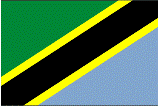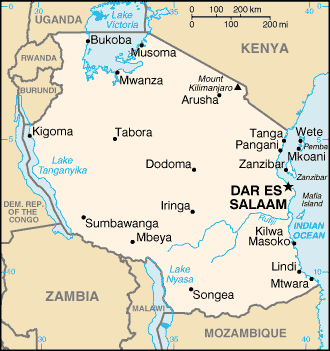|
Tanzania
|

|
Capital: Dodoma
Population: 58,005,463
Brief History of Tanzania:
People have lived in the area of Tanzania for thousands of years. Some of the oldest known remnants of humans have been found in Tanzania. The tribal peoples of the Bantu moved into the area around 2,000 years ago and organized city-states formed around 500 AD. In the 1700s the Arabs arrived and began to use Tanzania for the slave trade. The Sultan Seyyid Said claimed the coastal areas and made Zanzibar his capital city. Zanzibar soon became the main location for the Arab slave trade.
The first European to arrive was Portuguese explorer Vasco da Gama in 1498. Portugal claimed control of the coastland, but did not settle in the area. Portugal tried to maintain control of the ocean trade and to demand tribute from the local tribes. However, the Arab Omani soon forced Portugal from the area.
It was in Tanzania that Scottish missionary David Livingstone, who crusaded against the slave trade, was found by American journalist Henry Stanley and Stanley made his famous statement "Dr. Livingstone, I presume?" Stanley had been commissioned by the New York Herald to find David Livingstone.
Over the years the British became more involved in the area. In 1890 Zanzibar became a British Protectorate. At the same time Germany took control of other areas of Tanzania called Tanganyika. After World War II, the British took full control of both Zanzibar and Tanganyika until 1961 when Tanganyika became an independent country. In 1964 Tanganyika and Zanzibar merged to become Tanzania.
The Geography of Tanzania
Total Size: 945,087 square km
Size Comparison: slightly larger than twice the size of California
Geographical Coordinates: 6 00 S, 35 00 E
World Region or Continent: Africa
General Terrain: plains along coast; central plateau; highlands in north, south
Geographical Low Point: Indian Ocean 0 m
Geographical High Point: Kilimanjaro 5,895 m
Climate: varies from tropical along coast to temperate in highlands
Major cities: DODOMA (Capital), Dar Es Salaam 3.207 million (2009), Mwanza, Zanzibar City
The People of Tanzania
Type of Government: republic
Languages Spoken: Kiswahili or Swahili (official), Kiunguja (name for Swahili in Zanzibar), English (official, primary language of commerce, administration, and higher education), Arabic (widely spoken in Zanzibar), many local languages
Independence: 26 April 1964; Tanganyika became independent 9 December 1961 (from UK-administered UN trusteeship); Zanzibar became independent 19 December 1963 (from UK); Tanganyika united with Zanzibar 26 April 1964 to form the United Republic of Tanganyika and Zanzibar; renamed United Republic of Tanzania 29 October 1964
National Holiday: Union Day (Tanganyika and Zanzibar), 26 April (1964)
Nationality: Tanzanian(s)
Religions: mainland - Christian 30%, Muslim 35%, indigenous beliefs 35%; Zanzibar - more than 99% Muslim
National Symbol: Uhuru (Freedom) torch
National Anthem or Song: Mungu ibariki Afrika (God Bless Africa)
Economy of Tanzania
Major Industries: agricultural processing (sugar, beer, cigarettes, sisal twine); diamond, gold, and iron mining, salt, soda ash; cement, oil refining, shoes, apparel, wood products, fertilizer
Agricultural Products: coffee, sisal, tea, cotton, pyrethrum (insecticide made from chrysanthemums), cashew nuts, tobacco, cloves, corn, wheat, cassava (tapioca), bananas, fruits, vegetables; cattle, sheep, goats
Natural Resources: hydropower, tin, phosphates, iron ore, coal, diamonds, gemstones, gold, natural gas, nickel
Major Exports: gold, coffee, cashew nuts, manufactures, cotton
Major Imports: consumer goods, machinery and transportation equipment, industrial raw materials, crude oil
Currency: Tanzanian shilling (TZS)
National GDP: $67,900,000,000
** Source for population (2012 est.) and GDP (2011 est.) is CIA World Factbook.
Back to Geography Home Page
